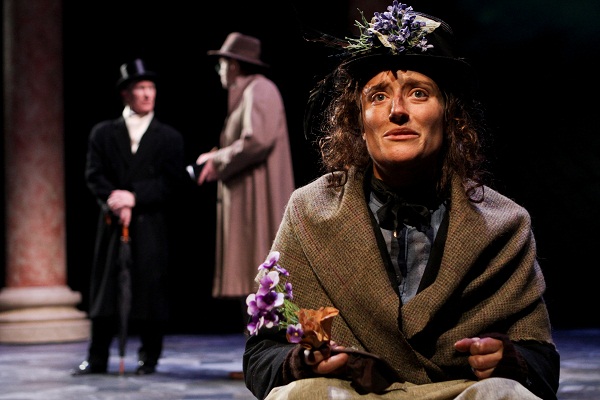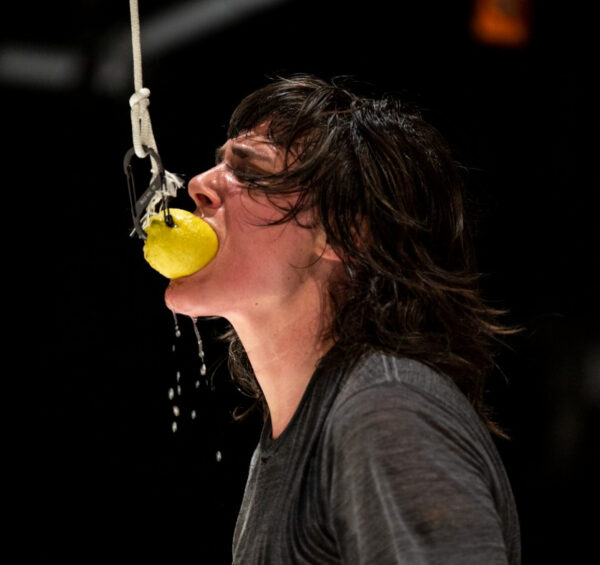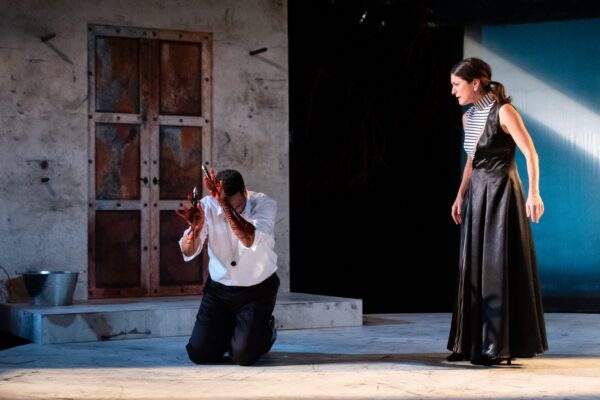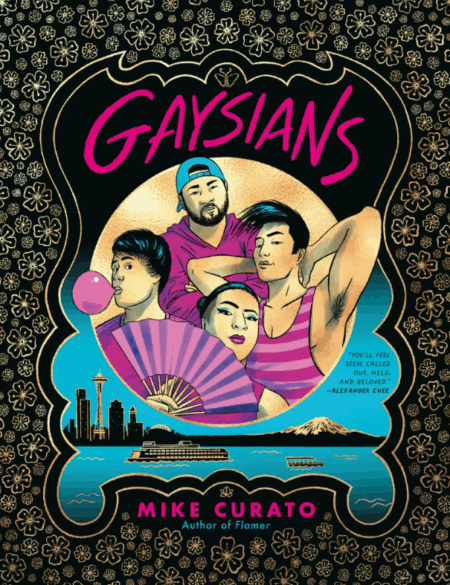
R. Hamilton Wright as Col. Pickering, Mark Anders as Henry Higgins, and Jennifer Lee Taylor as Eliza Doolittle in Seattle Shakespeare Company's production of Pygmalion. Photo by John Ulman
Review: Pygmalion by George Bernard Shaw. Produced by Seattle Shakespeare Company. Directed by Jeff Steitzer. With Mark Anders, Jennifer Lee Taylor, R. Hamilton Wright, A. Bryan Humphrey, and Jeanne Paulsen. Now through March 11, 2012 at Intiman Theater/Seattle Center.
Such a dull headline I know, but I didn’t want to obscure the facts: Seattle Shakespeare Company’s current production of George Bernard Shaw’s timeless play, “Pygmalion” is the most exciting new production in Seattle right now and everything about it is brilliant. Of course, the original play is iconic…there hasn’t been much doubt about that for the last one hundred years (almost). Shaw’s work was praised then and it’s been beloved ever sense, even in its watered down form as the delightful, but overtly romantic “My Fair Lady” (which is wittily referenced in the opening moments of Seattle Shakes’ production).
But, EVERYTHING about this production is just about perfect. Director Jeff Steitzer has done a brilliant job of creating a fresh, witty look at the material with innovative staging and the surprising presence of Shaw himself as a character in his own work. The cast, from the famous lead roles, down to the smallest walk ons, are all very well cast and give impeccable performances. The set design from Jason Phillips; the lighting work by Andrew D. Smith; the sound by Matt Starritt; the ridiculously gorgeous costumes by Deane Middleton…yes, they are all bloody brilliant. I’ve whined a bit in the past that sometimes Seattle Shakes, in their effort to stay in the black, can get a little heavy handed with the parsimony. There have been occasions where I thought their design work was a bit cheap looking…apparently, all that penny pinching has paid off. The sumptuous looks of the sets, costumes and props (also excellent work by Judith Shahn) in “Pygmalion” either means they opened up the piggy bank, or a very generous sponsor helped them out. The design aesthetic of this production recalls Intiman at its most spendy. You want to eat the set and steal all the clothes and props.
“Pygmalion”/”My Fair Lady” is a very well known work and I hate synopsis…you know the story by heart. Cockney flower girl Eliza Doolittle is taken in by the snooty noted dialect professor Henry Higgins on a dare: can he turn her from a Common Urchin into a Lady in six months? That bet is made by his good friend, Colonel Pickering; Henry Higgins’s mother offers some practical advice; Freddy Eynsford-Hill falls in love in Eliza and Eliza’s rascally father, Alfred Doolittle offers some delightfully shaggy comedy relief. We don’t have the songs of Lerner and Lowe or “The Rain in Spain” scene or the Ascot or even the Embassy Ball…those scenes are all played offstage in “Pygmalion” and frankly, we don’t miss them. The scenes we do have, however, are very familiar even if you’ve never seen the original play. Huge chunks of Shaw’s original dialogue were used for “My Fair Lady”, some of them set to music. The story is as familiar as a nursery rhyme.
But, “Pygmalion” is a bit deeper than Jack and Jill. Shaw’s work, influenced by the work of Ibsen and his “A Doll’s House” in particular, takes a strong look at male-female relationships and the growing independence of women in 20th Century life. Eliza doesn’t WANT to be a lady so she can marry a wealthy man and live the high life; her original goal is to improve herself enough to get a better paying job. Once she becomes a “lady” she bitterly cries she has lost her independence; when Higgins flippantly says she could marry, she rejects the offer and tacitly, Higgins as well. Some audiences have yearned for a more romantic ending for “Pygmalion”; surely Eliza comes back to Higgins, who obviously cares very much for her!?!? “My Fair Lady” gave them that “happy ending” but Shaw rejected it, and rightfully so. Eliza’s slipper throwing is her emancipation, the equivalent of Nora slamming the door at the end of “A Doll’s House”. It’s powerful and bold and the correct choice for her character. It’s why the play still reverberates after so many decades.
Well, that and it’s funny as hell. Some plays do not age well, (“Inherit the Wind” would be a good example) and the truly BRILLIANT ones (there’s that word again) seem as fresh as they did when they premiered. Mr. Steitzer’s already mentioned direction of this production just adds another take on material that is already relevant and relatable to modern audiences. Using the character of the author, George Bernard Shaw to perform his lengthy stage directions to set up the mise-en-scène is both innovative and makes good use of all that excellent material, (Shaw was famous for his highly detailed stage directions).
The role of “Shaw” was also amusingly performed by A. Bryan Humphrey doing double duty here as the author, and his creation Alfred Doolittle. Mr. Humphrey excelled as the erudite Shaw but really earned his kudos as the crowd pleasing Doolittle. It’s a role with obvious audience appeal; Alfred’s been earning laughs and raves for a very long time (Author’s note: I played the part, in “My Fair Lady”…it’s kind of impossible to NOT get audience love as Alfred.) And, Mr. Humphrey is pretty much impeccable in this role, nicely resisting the urge to overplay the comedy. His Alfred is sly, but rueful and very, very believable. It’s just a terrific performance.
He’s matched by the rest of the supporting cast. I’ve read this play and I’ve seen many productions of it and “My Fair Lady” and Colonel Pickering ALWAYS comes off as a bit of a ….boob. He’s never seemed very interesting; he’s just there to make a bet and serve as chaperone in the Higgins household. He’s just meh….until R. Hamilton Wright plays him. It shouldn’t really be a surprise because Bob Wright is a rightfully beloved actor in Seattle…he seems incapable of a crappy performance. Even in crappy roles in crappy productions, Bob Wright is always this shining treasure of acting purity. He’s done the unthinkable and made Colonel Pickering interesting and funny and viable and a vital piece of the play. Maybe the problem is, lazy actors have traditionally been cast in this role…it’s not a showy part. (In the musical, Pickering doesn’t even get his own song!) Mr. Wright proves that a thinking actor will read the text and interpret it correctly and make a well written role exciting and vital. I won’t be able to watch any other actor play Colonel Pickering without thinking of Mr. Wright’s excellent work.
Jeanne Paulsen, another local acting legend, looks far too young to play Mrs. Higgins but her performance is so dryly perfect you can excuse the fact she apparently was 10 when she gave birth to Henry. In the smaller roles of the Eynsford -Hills: Mother, Daughter and Son, Freddy…Marty Mukhalian, Amy Hill and Trick Dannecker give strong nuanced performances that subtly enhance the reduced situation of the family. And, Beth A. Cooper makes a commanding but resigned Mrs. Pearce, Henry Higgin’s much put upon housekeeper. Excellent work by the entire cast.
And, that brings us to our leads, Henry Higgins and Eliza Doolittle, the center of our little comedic non-romance. At first, I was a bit put off by Mark Anders’ performance as Higgins…it seemed a little subdued and timid, (and the thought did cross my mind: “Why isn’t Bob Wright playing this role?”) But, I think that early reticence in the performance is a deliberate choice, and a wise one, to ease into the power and fury of Higgins, who it must be faced, is rather an insufferable ass at times and when overplayed, can seem overly unsympathetic. But, Mr. Anders does an excellent job of playing the small moments as well as the big ones; there are times when he is very gentle and very precise with his acting. His Higgins is 85% lion, 10% fox and 5% pussy cat. There’s some delicious shadings between all the various aspects of his Henry Higgins. It’s strong, fine work.
As for our Eliza, I’ve had a soft spot for Jennifer Lee Taylor for quite some time…she’s a terrific local actress who’s equally strong with comedy and drama and frequently both in the same play. She always seems to find the humor in the darkness and the tragedy in the humor. (Case in point: her delightful work as the Mermaid in New Century’s “O Lovely Glowworm” last year). Yes, her Cockney maid is all dropped “aitches” and guttural cries of anguish in the opening two acts and the humor is played divinely. But, it’s the later acts, after Eliza has become a lady, where Ms Taylor has to create a more layered and precise character. Cockney Eliza is all surface emotions but Lady Eliza has to play anger, and betrayal, and bitterness, and heartache with that steely resolve she’s always had. (And, be funny when called upon.) It’s a complex role (it’s really two roles) and the actress blends them perfectly together. I think sensible people will want to cheer when her Eliza makes her Cry for Independence. You want her to succeed without any more help from Henry Higgins. She’s earned it and she deserves it. And, Ms Taylor deserves a lot of praise for her work here.
Smart theater goers deserve to find out for themselves. Seattle Shakespeare Company’s “Pygmalion” is really a must see production for those who enjoy BRILLIANTLY acted, directed, produced, and designed theater. It’s a mid-winter treat…and, you won’t even miss those unnecessary (but pretty) Lerner and Lowe songs. You can listen to the album when you get home from this “Pygmalion”.














